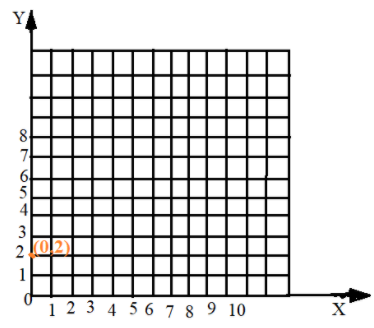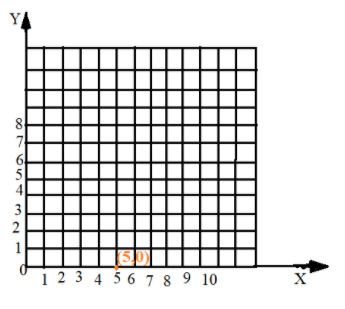
State whether True or False. Correct that is false.
(i) A point whose $x$ coordinate is zero and $y$ coordinate is non-zero will lie on the $y$- axis.
(ii) A point whose $y$ coordinate is zero and the $x$ coordinate is 5 will lie on the $y$ axis.
(iii) The coordinates of the origin are $\left( {0,0} \right)$
Answer
576.6k+ views
Hint: Plot any point such that it satisfies the given condition in part (i) and check if the statement holds true. Next, write the coordinates of the point mentioned in part (ii) and then plot the point to determine if the statement is correct or not. In the last statement, recall the definition of origin and find the coordinates of the intersection of both the axes.
Complete step by step solution: We have to find if the given statement, “A point whose $x$ coordinate is zero and $y$ coordinate is non-zero will lie on the $y$- axis”, is true or false.
Let us first take any point whose $x$ coordinate is zero and $y$ coordinate is non-zero, say $\left( {0,2} \right)$
We have to find if the point lies on the \[y\] axis.
If the coordinate of the point is $\left( {0,2} \right)$, it means the point is at 0 units horizontally from the origin and 2 units at a vertical distance from the origin.

In general, any point with 0 as $x$ coordinate and non-zero $y$ coordinate will lie on the $y$- axis.
Therefore, the statement, “A point whose $x$ coordinate is zero and $y$ coordinate is non-zero will lie on the $y$- axis”, is true.
Next, the given statement in part (ii) is “A point whose $y$ coordinate is zero and the $x$ coordinate is 5 will lie on the $y$ axis”.
The coordinates for the given statement can be written as $\left( {5,0} \right)$
Plot the point on the graph to check the position of the point.

Here, we can see that the coordinate $\left( {5,0} \right)$ is on the $x$ axis.
Therefore, the statement “A point whose $y$ coordinate is zero and the $x$ coordinate is 5 will lie on the $y$ axis” is false.
And the correct statement is A point whose $y$ coordinate is zero and the $x$ coordinate is 5 will lie on the $x$ axis.
In part (iii), we are given the statement, “The coordinates of the origin are $\left( {0,0} \right)$”
The intersection of $x$ and $y$ axis is the origin and the coordinates of origin are $\left( {0,0} \right)$
Thus, the given statement, “ The coordinates of the origin are $\left( {0,0} \right)$” is true.
Note: Students should know how to plot any point on the cartesian plane. In the rectangular coordinate system, the axes, $x$ axis and the $y$ axis are perpendicular to each other. The intersection of both the axes represents the origin and any point in the coordinate system is written as $\left( {x,y} \right)$, where $x$ coordinate is known as abscissa and $y$ coordinate is also known as ordinate.
Complete step by step solution: We have to find if the given statement, “A point whose $x$ coordinate is zero and $y$ coordinate is non-zero will lie on the $y$- axis”, is true or false.
Let us first take any point whose $x$ coordinate is zero and $y$ coordinate is non-zero, say $\left( {0,2} \right)$
We have to find if the point lies on the \[y\] axis.
If the coordinate of the point is $\left( {0,2} \right)$, it means the point is at 0 units horizontally from the origin and 2 units at a vertical distance from the origin.

In general, any point with 0 as $x$ coordinate and non-zero $y$ coordinate will lie on the $y$- axis.
Therefore, the statement, “A point whose $x$ coordinate is zero and $y$ coordinate is non-zero will lie on the $y$- axis”, is true.
Next, the given statement in part (ii) is “A point whose $y$ coordinate is zero and the $x$ coordinate is 5 will lie on the $y$ axis”.
The coordinates for the given statement can be written as $\left( {5,0} \right)$
Plot the point on the graph to check the position of the point.

Here, we can see that the coordinate $\left( {5,0} \right)$ is on the $x$ axis.
Therefore, the statement “A point whose $y$ coordinate is zero and the $x$ coordinate is 5 will lie on the $y$ axis” is false.
And the correct statement is A point whose $y$ coordinate is zero and the $x$ coordinate is 5 will lie on the $x$ axis.
In part (iii), we are given the statement, “The coordinates of the origin are $\left( {0,0} \right)$”
The intersection of $x$ and $y$ axis is the origin and the coordinates of origin are $\left( {0,0} \right)$
Thus, the given statement, “ The coordinates of the origin are $\left( {0,0} \right)$” is true.
Note: Students should know how to plot any point on the cartesian plane. In the rectangular coordinate system, the axes, $x$ axis and the $y$ axis are perpendicular to each other. The intersection of both the axes represents the origin and any point in the coordinate system is written as $\left( {x,y} \right)$, where $x$ coordinate is known as abscissa and $y$ coordinate is also known as ordinate.
Recently Updated Pages
Why are manures considered better than fertilizers class 11 biology CBSE

Find the coordinates of the midpoint of the line segment class 11 maths CBSE

Distinguish between static friction limiting friction class 11 physics CBSE

The Chairman of the constituent Assembly was A Jawaharlal class 11 social science CBSE

The first National Commission on Labour NCL submitted class 11 social science CBSE

Number of all subshell of n + l 7 is A 4 B 5 C 6 D class 11 chemistry CBSE

Trending doubts
What is meant by exothermic and endothermic reactions class 11 chemistry CBSE

10 examples of friction in our daily life

One Metric ton is equal to kg A 10000 B 1000 C 100 class 11 physics CBSE

1 Quintal is equal to a 110 kg b 10 kg c 100kg d 1000 class 11 physics CBSE

Difference Between Prokaryotic Cells and Eukaryotic Cells

What are Quantum numbers Explain the quantum number class 11 chemistry CBSE




